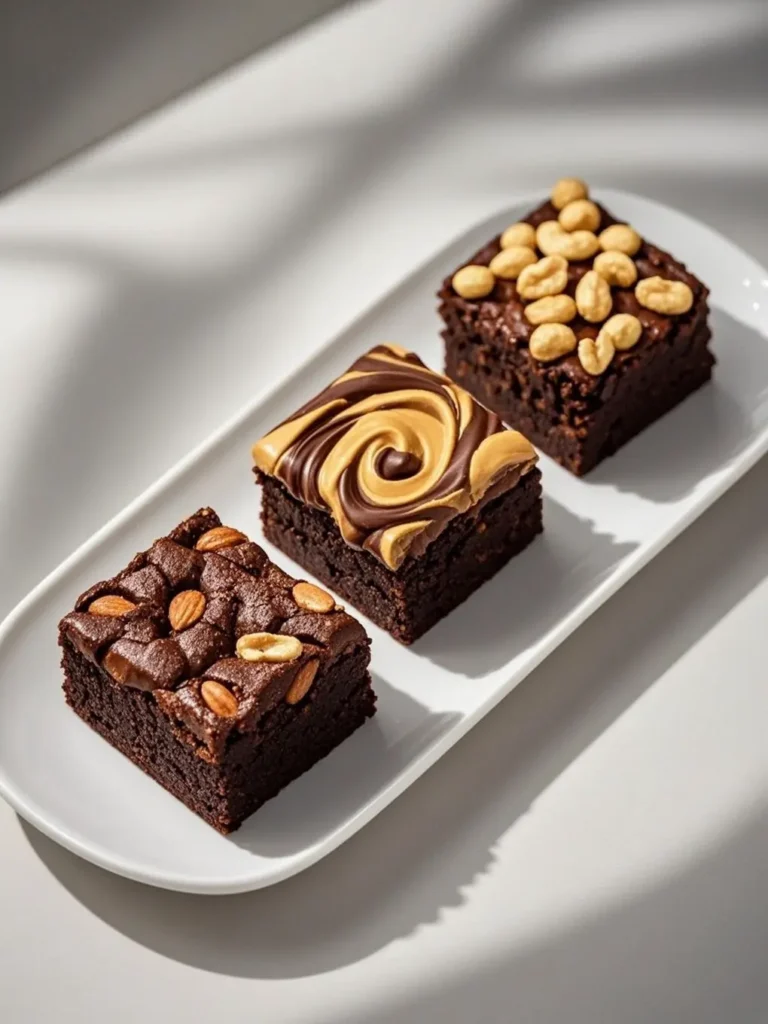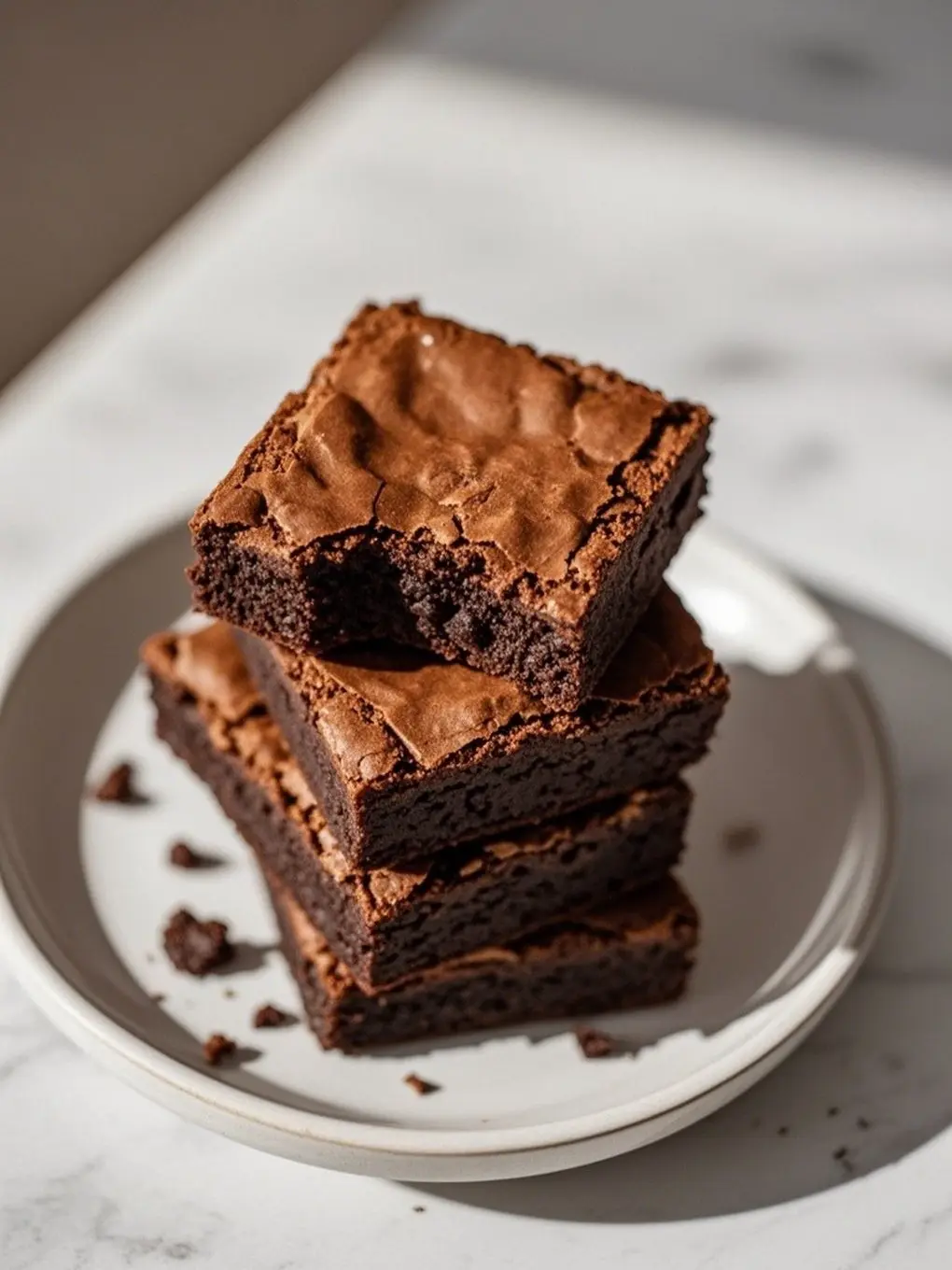Okay, let’s cut to the chase not all brownies are created equal. Some are cakey, others are gooey in the middle, and then there are Chewy Brownies : that perfect middle ground between fudgy and firm. You know the kind rich, dense, with just the right bite that sticks to your teeth in the best way.
Honestly, chewy brownies are the unsung heroes of the brownie world. They’re the ones that hold their shape when you pick them up, don’t fall apart under a scoop of ice cream, and keep that just-baked texture for days (if they last that long).
So what makes a brownie chewy?
It’s all about balance a little extra fat, just the right amount of flour, and the perfect bake time. If you’ve ever tried to make brownies and ended up with something that felt more like chocolate cake or collapsed into fudge soup, don’t worry I’ve been there too. This guide is gonna walk you through everything you need to know to master chewy brownies once and for all.

We’ll talk ingredients (because yes, the kind of sugar you use matters), techniques, mistakes to avoid, and even some fun variations if you’re feeling adventurous. Whether you’re baking for a crowd or just need something sweet after a long day, this chewy brownie recipe is about to be your new go-to.
Key Ingredients for the Perfect Chewy Brownies
If you’ve ever followed a brownie recipe to the letter and still ended up with a fluffy cake square instead of that dense, rich chew you’re not alone. The secret’s not just in the recipe, it’s in how those ingredients come together. Let’s break it down.
Choosing the Right Chocolate
You want bold, deep chocolate flavor without overloading on sweetness. For that perfect chewy bite, use:
- Unsweetened cocoa powder (preferably Dutch-process) – It gives you a dense texture and rich flavor.
- Melted dark chocolate or semi-sweet chips – Adds moisture and richness.
Avoid milk chocolate here. It’s too soft and sweet, which can mess with both flavor and structure.
The Role of Fats: Butter vs. Oil
Here’s where chewiness is born.
- Butter gives you flavor and richness.
- Oil (like canola or vegetable) gives you that flexible, stick-to-your-teeth chew.
For the ultimate chewy brownie? Use both. A combo of melted butter and a little oil gets you deep flavor and the ideal chew factor.
Reminds me of how adding mayo instead of butter can totally change the texture in savory recipes like these mayo-free deviled eggs. Texture is everything.
Importance of Sugar Types
White sugar makes brownies crispier on top, while brown sugar adds chew.
- Use a mix of light brown sugar and granulated sugar for that shiny top and soft middle.
- Too much brown sugar and your brownies might get greasy, though balance is key.
Eggs: Whole vs. Yolks
Eggs bind the ingredients and add richness. Here’s the pro tip:
- Use 1 whole egg + 1 extra yolk. That yolk adds fat and emulsifies everything for a denser texture.
It’s a subtle thing that makes a big difference in chewiness.
Flour Selection and Its Impact
Don’t overdo it here.
- Use all-purpose flour, and stick to about ¾ cup for an 8×8 pan. More flour = cakier brownies.
- Want to go slightly healthier? Try a mix of AP flour and a spoon of almond flour or oat flour but not too much.
Also, don’t forget to sift your cocoa powder and flour together. Lumps = uneven texture.
Optional Add-ins for Texture and Flavor
If you wanna get wild (and you should), here are some chewy-friendly mix-ins:
- Chocolate chunks or chips – double down on chocolate
- Walnuts or pecans – add crunch without messing with chew
- Mini marshmallows or peanut butter chips – gooey pockets of extra joy
And if you’re craving full-on chocolate drama, you can always turn to something like the brownie cake
Step-by-Step Instructions for Making Chewy Brownies
Whether you’re baking from scratch or tweaking a boxed mix (no judgment here), getting that chewy texture comes down to technique as much as ingredients. Here’s your foolproof method.
Step 1: Prep Your Pan Like a Pro
Start with an 8×8 or 9×9 metal baking pan. Avoid glass if you can it doesn’t conduct heat evenly and can overbake the edges before the middle sets.
- Line the pan with parchment paper, leaving extra hanging over the sides for easy lifting.
- Lightly spray or butter the parchment. You want clean removal without sticking or tearing.
If you’ve ever had to chisel brownies out of a dish, you know the struggle is real. Let’s not go back there.
Step 2: Melt the Chocolate and Fats
In a heatproof bowl, combine:
- ½ cup unsalted butter
- ¼ cup neutral oil (like canola or grapeseed)
- 1 cup semi-sweet chocolate chips or chopped dark chocolate
Melt gently over a pot of simmering water (double boiler style), or use the microwave in 30-second bursts, stirring between each round.
Let it cool for about 5 minutes so it doesn’t scramble the eggs later.
Step 3: Whisk in the Sugar and Eggs
Add:
- ¾ cup white sugar
- ½ cup packed light brown sugar
Whisk until fully combined and glossy. Then beat in:
- 2 large eggs
- 1 additional egg yolk
- 1 teaspoon vanilla extract
Whisk for at least 1–2 minutes to get that glossy top and emulsify the fats and sugars. This is the key to that shiny, crinkly crust you love.
Step 4: Mix in the Dry Ingredients
In a separate bowl, sift together:
- ¾ cup all-purpose flour
- ½ cup cocoa powder (Dutch-process if possible)
- ¼ teaspoon salt
Fold into the wet mixture using a spatula not a whisk. You want to stop mixing as soon as the flour disappears. Overmixing develops gluten, and that means cakey brownies. Not today.
If you’re adding extras (chocolate chunks, nuts, etc.), toss them in now.
Step 5: Pour and Bake
Pour the batter into your prepared pan and smooth the top. Tap the pan on the counter a few times to release air bubbles.
Bake at 325°F (163°C) for 28–32 minutes, depending on your oven. You want a toothpick inserted into the center to come out with moist crumbs, not wet batter.
- Underbake slightly for maximum chew.
- Overbake and you’ll lose that dreamy texture.
Let them cool completely in the pan before slicing trust me, it’s worth the wait. Warm brownies are messy; cooled brownies slice clean and chewy.
Variations of the Classic Chewy Brownie Recipe
There’s nothing wrong with a classic but sometimes, you want to switch things up. These chewy brownie variations will help you accommodate dietary needs without sacrificing that signature texture.
Gluten-Free Chewy Brownies
No wheat? No problem. With the right flour blend, you can make brownies that are just as rich and chewy as the original.
What to use:
- A 1:1 gluten-free all-purpose flour blend
- Almond flour (adds moisture and nuttiness, but use sparingly)
- Coconut flour (be careful it absorbs a ton of moisture, so only sub a small amount)
Pro tip: Add ½ teaspoon xanthan gum if your flour blend doesn’t already include it. This helps mimic the structure that gluten would normally provide.
Looking for more gluten-free comfort food? Try this cornbread stuffing without eggs perfect for pairing with a sweet treat.
Vegan Chewy Brownies
You can totally go egg- and dairy-free and still get chewy, chocolatey goodness.
Easy swaps:
- Replace eggs with flax eggs (1 tbsp ground flax + 3 tbsp water = 1 egg)
- Use plant-based butter or coconut oil
- Stick with dark chocolate (check the label for dairy-free)
Tip: Add a tablespoon of nut butter or mashed avocado for extra richness and moisture. Don’t knock it till you try it.
Nutty & Swirly Variations
Want a little texture or flavor twist in every bite? Try these fun mix-ins:
- Walnuts or pecans – Add crunch and contrast
- Peanut butter or almond butter swirls – Just dollop and swirl before baking
- Cream cheese – For cheesecake brownies, mix 8 oz cream cheese, ¼ cup sugar, and an egg, then swirl in
- Raspberry jam or caramel drizzle – Adds sweet bursts and gooey streaks
Or go full dessert overload with crushed Oreos or mini peanut butter cups because why not?
If you’re loving the idea of creative combos, don’t miss the peach crumble or matcha brownies on Swefty for your next sweet fix.
Common Mistakes to Avoid When Baking Chewy Brownies
Even the best recipe can flop if the baking process goes sideways. Brownies may seem simple, but getting that ideal chewy texture means knowing what not to do. Here’s your cheat sheet for avoiding brownie heartbreak.
Mistake #1: Overmixing the Batter
You want to combine ingredients, not beat the life out of them.
Why it’s bad: Overmixing develops gluten, especially once flour is added. This leads to tough, cakey brownies. Not the chewy vibe we’re after.
Fix: Fold in your dry ingredients gently with a spatula just until they disappear. Then stop. Seriously. Walk away.
This same hands-off strategy also helps when making soft baked goods like sweet potato pie overmixing? Cracks and sadness.
Mistake #2: Baking Too Long
Overbaking is the #1 reason chewy brownies turn cakey or dry. Even a few extra minutes can throw off the texture.
Fix: Start testing early (around 28 minutes) and pull them out when a toothpick inserted comes out with a few moist crumbs not dry, not wet. Trust the process, and let them finish setting as they cool.
Mistake #3: Wrong Pan = Wrong Texture
Glass and ceramic pans retain heat and can overbake your brownies after they’re out of the oven.
Fix: Use a light-colored metal pan for even baking. And line it with parchment for easy lift-out. This keeps edges from crisping too hard while the middle stays soft.
Kind of like how a good pan matters in savory recipes like this chicken and gravy dish, the bakeware really can make or break the outcome.
Mistake #4: Not Letting Them Cool
It’s so tempting to slice into warm brownies, but that’ll wreck the structure and turn your perfect layers into mushy mess.
Fix: Cool in the pan for at least 1 hour, or chill in the fridge for 20–30 minutes for cleaner slicing and extra chew.
You’ll get those crisp edges, chewy centers, and defined layers that everyone’s after.
Storing and Serving Chewy Brownies Like a Pro
You nailed the bake, the edges are crisp, the center’s chewy now don’t ruin it with bad storage or a rushed presentation. Here’s how to keep your brownies fresh and serve them like the gooey superstars they are.
How to Store for Maximum Freshness
Chewy brownies can last up to a week, but only if you store them right.
- At Room Temp: Place brownies in an airtight container with a sheet of parchment between layers. Keep them on the counter up to 4–5 days.
- In the Fridge: Store in a sealed container for up to a week. Bring to room temp before serving for that perfect chew.
Pro tip: Add a slice of bread to the container (yep, really). It keeps them soft by absorbing any extra moisture loss.
Kind of like the trick for saving moist cornbread dressing, this little hack is simple but seriously effective.
Can You Freeze Chewy Brownies?
Absolutely. Chewy brownies freeze like a dream.
- Wrap individual squares in plastic wrap, then pop into a freezer-safe zip bag or airtight container.
- Freeze for up to 3 months.
To serve, just thaw at room temp for 30–60 minutes, or microwave for 10–15 seconds for warm, gooey glory.
Creative Serving Ideas
Brownies are great straight from the pan but if you want to show off a little, here are a few fun ways to dress them up:
- Brownie Sundaes: Top a warm brownie with vanilla ice cream, hot fudge, whipped cream, and sprinkles. Yes please.
- Brownie Bites: Cut into small squares and serve in mini cupcake liners at parties or potlucks.
- Brownie S’mores: Sandwich a brownie square between graham crackers with toasted marshmallow. Wild. Messy. Worth it.
- Layered Dessert Jars: Crumble brownie chunks into a mason jar layered with whipped cream, berries, or pudding.
Need another decadent dessert to pair them with? Try the creamy Crumbl cookie recipe for the ultimate bake-off spread.
Nutritional Information and Considerations
Look, nobody’s eating brownies for the fiber. But if you’re curious about what’s in a typical chewy brownie square or you want to make your batch a little lighter, I got you.
Caloric Content per Serving
One classic 2×2″ chewy brownie square (from a standard 8×8 pan, cut into 16) typically contains:
- 200–250 calories
- 12–15g of sugar
- 10–12g of fat
- 2–3g protein
This can go way up if you’re adding extras like peanut butter, caramel, or candy chunks but also, worth it.
If you’re pairing brownies with something lighter for balance, a clean protein like the shredded chicken from this rotisserie chicken casserole can round out your plate.
Adjusting Ingredients for Healthier Options
Trying to enjoy your brownies without throwing your goals out the window? Here are a few pro tweaks:
- Swap butter for avocado or Greek yogurt (you’ll lose a bit of richness, but gain nutrients)
- Use coconut sugar or maple syrup in place of white sugar for a lower-glycemic option
- Replace some of the flour with almond flour or oat flour for fiber and protein
- Use dark chocolate chips (70%+) for a deeper flavor and less added sugar
You could even add a scoop of collagen powder or unflavored protein into the batter. It’s a fun way to sneak in a little nutritional boost while keeping the texture on point.
Want to go all in on protein-packed desserts? Check out these cottage cheese bagels they’re a savory snack with major staying power.

Chewy Brownie Recipe
Ingredients
Method
- Preheat oven to 350°F (175°C). Grease an 8×8-inch baking pan or line it with parchment paper.
- In a medium saucepan, melt the butter over low heat. Remove from heat and stir in sugar, eggs, and vanilla.
- Whisk in cocoa powder, flour, salt, and baking powder until just combined.
- Fold in chocolate chips or chunks if using.
- Pour the batter into the prepared pan and spread evenly.
- Bake for 20–25 minutes or until a toothpick inserted near the center comes out with a few moist crumbs.
- Let cool before slicing into squares and serving.
Nutrition
Notes
Tried this recipe?
Let us know how it was!Conclusion: Mastering the Art of Chewy Brownies
Let’s face it chewy brownies are the MVP of chocolate desserts. They hit that sweet spot between dense and fudgy, soft and firm, rich and irresistible. Whether you love yours loaded with chocolate chips, swirled with peanut butter, or cut into tiny bite-sized squares you swear you’ll “just taste,” the beauty of chewy brownies is that they’re customizable, forgiving, and downright crave-worthy.
The secret? It’s not just one thing it’s about balancing ingredients, baking just enough (but not too much), and knowing when to step away from the mixer. From using the right combo of fats to tossing in that extra yolk and embracing underbaking, you’ve now got the blueprint for brownie greatness.
So whether you’re baking a batch for yourself, surprising your family, or showing up to a potluck with something that’ll disappear in five minutes flat this chewy brownie recipe is your new go-to. Trust me, it’s the kind of treat that turns first bites into wide-eyed “what-is-this-magic” moments.
FAQs: Answers to Your Chewy Brownies Recipe Questions
What’s the secret to chewy brownies?
The secret lies in a balance of ingredients: a mix of oil and butter for moist richness, brown sugar for density, and an extra egg yolk for that signature chew. Underbaking slightly and letting the brownies cool completely also helps lock in that perfect texture.
What makes brownies chewy vs fudgy?
Chewy brownies have more structure and bite due to slightly more flour and sugar, especially brown sugar. Fudgy brownies, on the other hand, are richer and denser because of higher fat content and less flour. It’s all in the ratio of fat to dry ingredients and how long they bake.
Do more eggs make brownies chewier?
Not exactly—more eggs often make brownies cakier. To increase chewiness, use one whole egg and an extra yolk. The yolk adds fat and binds everything without adding air, which helps keep the texture dense and chewy instead of fluffy.
How many eggs for chewy brownies?
For best results, use 2 large eggs plus 1 extra yolk in an 8×8 pan recipe. This combination gives you richness and chew without crossing into cake territory. It also helps that chewy, glossy top layer form as the eggs bind with sugar and chocolate.
What makes brownies rubbery?
Rubbery brownies usually happen when you overmix the batter or overbake them. Stirring too much develops gluten, which leads to a dense, tough texture. Too much flour or not enough fat can also make them stiff instead of chewy.
What is the secret ingredient in brownies?
Aside from love? Honestly—it’s brown sugar. The molasses in brown sugar helps retain moisture and adds depth of flavor and chew. A touch of espresso powder is another game-changer—it enhances the chocolate flavor without making the brownies taste like coffee.
